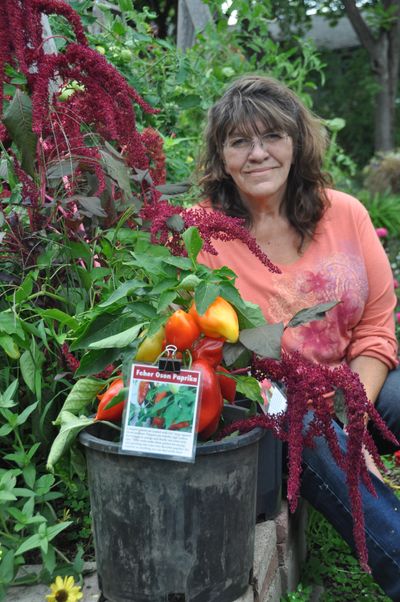Gardening: Elizabeth Casteel, known as ‘Tomato Lady,’ also a pepper master

This seemed to be a cool summer, and many gardeners experienced hit-and-miss vegetable gardens because of it. Some folks had bumper crops while others replanted stuff two and three times. My corn and onions failed, and the deer ate my zucchini and summer squash. I had more raspberries and blackberries than I knew what to do with. Go figure.
One of the lucky ones this year was Elizabeth Casteel. We all know her as the Tomato Lady who sells tomato starts at Garden Expo each spring. She is also a master at growing peppers. That was obvious as we walked past 4- and 5-foot tall King of the North and Bull’s Horn pepper plants in her Spokane Valley garden. So, what are some of Casteel’s tips for successfully growing peppers here?
Casteel starts her peppers indoors in late January to early February. “Some varieties can take two months to germinate.” Once the plants have two to three true leaves, she pots them up in 3 1/2-inch pots under lights. She uses Promix potting mix with a little manure thrown in for good measure. She used four big bales of it last spring. By early April, she moves all her plants out to her greenhouses, so they get lots of sunlight.
The plants are fertilized each week with a half strength blend of steamed bone meal, worm castings, Epsom salts, mycorrhizae, seaweed extract, fish fertilizer, kelp and alfalfa meal. “The biggest pest problem I have is aphids that attack the plants when they are young.” She treats them with conventional sprays after trying several organic treatments that didn’t work.
Casteel’s favorite seed suppliers are Johnny’s Select Seed and Baker Creek. She particularly likes Baker Creek because they have a lot of unusual varieties. “Be sure you use fresh seed each year,” she said. The germination rate drops off quickly the second year and beyond.
“Peppers like heat,” Casteel said. “Lots of it.”
As a result, when it comes time to turn out the plants to really grow, she pots them up into 12-inch black plastic nursery pots that are either set out in sunny spots in the garden or left in the greenhouse. With the pots exposed to the sun, the soil heats up faster and stays warm. “Peppers need as much sun as they can get, at least a minimum of six hours a day,” she said.
It helps that Casteel’s Spokane Valley garden is in a protected area away from any cold microclimates and sheltered from the wind. Peppers also need a steady supply of water through the growing season. The one exception Casteel says is if you want really hot peppers, you need to cut back on the watering as they start to turn color.
“A lot of people think peppers are ripe when they are green, but they aren’t. That’s only the beginning.”
Casteel’s current crop of peppers range in colors of red, orange, yellow, purple and white. Many of them get sweeter and hotter as they turn color.